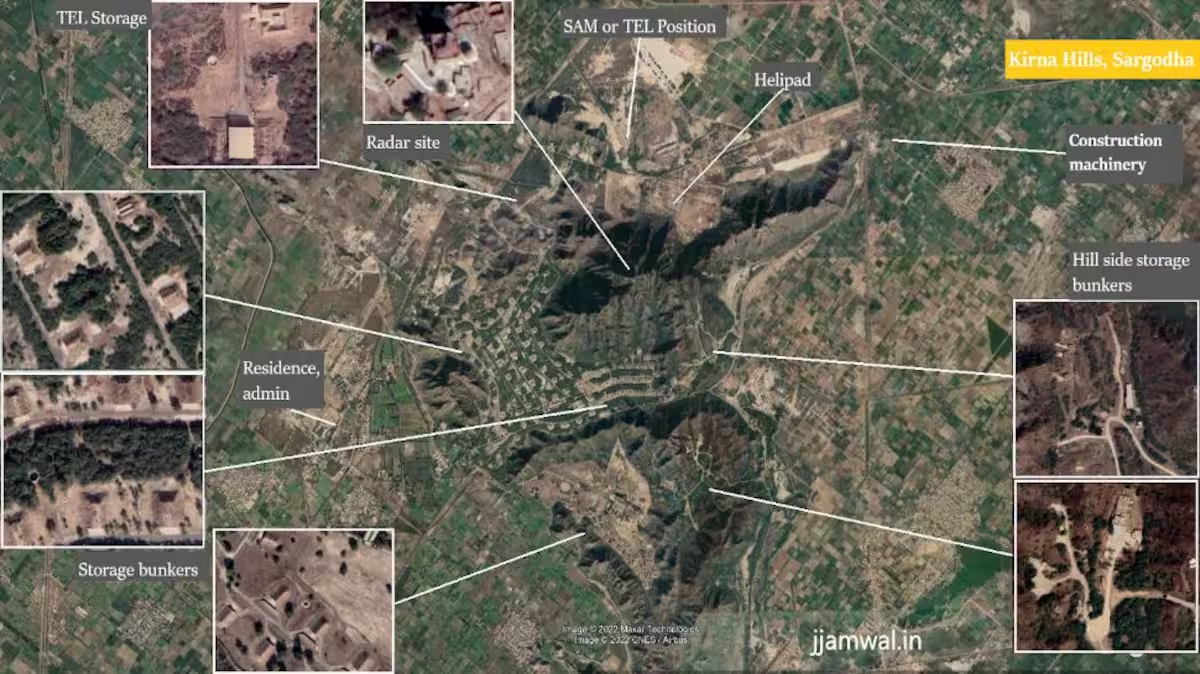India’s Precision Strikes Near Pakistan Nuclear Installations in Bold Show of Force
India’s Strikes on Kirana Hills: Precision Attack on Pakistan Nuclear Installations or Nuclear Brinkmanship?
New Delhi, May 12, 2025 — A bold and potentially perilous chapter has unfolded in the long-standing rivalry between India and Pakistan. On May 7, India launched Operation Sindoor, a calculated and high-precision series of airstrikes in retaliation for a brutal terror attack in Jammu and Kashmir that left 26 civilians dead. The operation’s most controversial target: Kirana Hills, a shadowy site in Pakistan long rumoured to be a core component of its nuclear arsenal.
Though the dust of war may have briefly settled under a ceasefire declared on May 10, the geopolitical aftershocks continue to reverberate. Unconfirmed/confirmed satellite images, unverified social media claims, and conflicting narratives from both nations have fueled speculation that India may have struck at the heart of Pakistan’s nuclear deterrence—an act that could recalibrate the region’s fragile strategic balance.
Operation Sindoor: A Calculated Response

The operation came just over two weeks after the April 22 terror attack in Pahalgam, Jammu and Kashmir—a tragedy that claimed the lives of civilians, including tourists. India swiftly blamed Pakistan-based terror outfits and responded with unprecedented force. Operation Sindoor targeted nine locations across Pakistan and Pakistan-administered Kashmir, including strategic airbases at Nur Khan (Rawalpindi), Rahim Yar Khan, and Sargodha.
Yet, it is the reported strike on Kirana Hills, a rugged fortified region in Punjab province, that has sparked the greatest international alarm. Indian sources suggest bunker-buster bombs and BrahMos supersonic cruise missiles were deployed to breach deeply buried installations suspected of housing nuclear warheads and delivery systems.
Pakistani authorities flatly deny such claims, stating the strikes hit “empty hillsides” and caused no critical damage. The fog of war, thickened by propaganda and misinformation, leaves much unclear. The Pakistani reporting, as usual, continues to spread misinformation to the people of Pakistan, like the way they did in the 1965 war and the 1971 war.
Satellite Clues and the Shadows of the Underground
Satellite imagery released by Indian firm Kawa Space and Chinese company MizazVision indicates structural damage at multiple Pakistani military sites, including a hangar at Bholari Airbase and infrastructure at Nur Khan. As for Kirana Hills, imagery shows disturbed terrain, suggestive of subterranean impact.
Some reports suggest that U.S. Department of Energy aircraft has landed at Islamabad, Pakistan, to monitor nuclear facilities.
— BhikuMhatre (@MumbaichaDon) May 11, 2025
Is it true?
If yes- has #Modi Sarkar taken 'temporary pause' for some reason which no-one of us know about?
Your take? pic.twitter.com/DH83ITU1tP
Adding to the speculation, some X (formerly Twitter) users claimed the detection of U.S. Department of Energy aircraft in Pakistani airspace, ostensibly scanning for radiation leaks in Pakistan Nuclear Installations. These claims remain unverified, but have intensified fears of a covert nuclear incident.
Kirana Hills: Pakistan Nuclear Installations Centre?
Nestled near Sargodha, Kirana Hills has long stood as a silent sentinel of Pakistan Nuclear Installations capability. Concealed tunnels reportedly dating back to the 1980s may house tactical and strategic warheads—vital components of Pakistan’s doctrine of nuclear deterrence.
Indian military insiders describe the strike as both “symbolic and strategic.” According to a senior official, “The message was clear: no target is beyond our reach—not even those protected by the nuclear shield.” The operation’s aim, Indian Air Marshal AK Bharti explained during a May 11 briefing, was to dismantle terror camps and vital military assets with minimal collateral damage. He did not specifically reference Kirana Hills.
Pakistan’s military, however, fired back with accusations of misinformation. Lt. Gen. Ahmed Sharif Chaudhry labelled India’s claims “propaganda,” accusing New Delhi of targeting civilians, including a mosque in Ahmedpur Sharqia, where five were killed.

Global Alarm Bells and the Spectre of Escalation
The possibility that a Pakistan Nuclear installation may have been targeted—intentionally or not—has deeply unsettled global powers. The U.S., China, and Russia quickly issued calls for restraint. U.S. Vice President J.D. Vance reportedly contacted Prime Minister Narendra Modi directly after receiving “alarming intelligence,” urging an immediate de-escalation. Diplomatic pressure culminated in a ceasefire on May 10, but anxiety remains.
Experts warn that even a perceived threat to Pakistan Nuclear Installations could prompt an escalatory spiral. “The risk of miscalculation is enormous,” said Dr. Nitasha Kaul, Director at the Centre for the Study of Democracy. “A strike on—or near—a nuclear site could breach Pakistan’s doctrinal threshold for tactical nuclear retaliation.”
The International Atomic Energy Agency (IAEA) has refrained from direct comment, issuing only a general appeal for nuclear safety and restraint. Meanwhile, whispers of U.S. radiation monitoring persist, with no conclusive findings disclosed.
A Battlefield of Narratives and Misinformation
With little concrete evidence, a war of narratives rages. Indian outlets, citing unnamed military sources, tout the strikes as a blow to Pakistan’s overreliance on Chinese radar systems, claiming vulnerabilities at Nur Khan and other sites. The Economic Times reported that India struck 11 airbases in total—assertions dismissed by Islamabad.
Across the border, Pakistan accuses India of exaggeration and political theatre, alleging that doctored images were circulated to mask civilian casualties. Social media platforms have become echo chambers of unverifiable claims—among them, a purported Indian strike on Kahuta Research Laboratories, and alleged NASA-detected radiation spikes at Kirana Hills. Both have been flagged as misinformation.
According to Swarajya Magazine, Pakistan too has played the propaganda game—circulating manipulated satellite images showing damage to India’s S-400 air defence systems, for which no evidence exists.
An Uneasy Pause: What Lies Ahead
The current ceasefire may hold, but the fundamental fault lines—Kashmir, terrorism, nuclear posturing—remain raw and unresolved. Operation Sindoor, especially if it targeted Pakistan Nuclear Installations’ infrastructure, signals a bold recalibration in India’s strategic doctrine: a willingness to challenge nuclear deterrence with surgical conventional force.
Pakistan now faces a dual pressure—to preserve strategic credibility without triggering wider conflict. The efficacy of its Chinese-supplied defence systems is under scrutiny, and relations with Beijing may be strained.
In a statement on May 11, U.S. President Donald Trump offered to mediate a long-term resolution to the Kashmir dispute, proposing trade incentives as part of a peace framework. Yet analysts remain sceptical, viewing such gestures as symbolic rather than substantial.
For now, the world watches with bated breath. Whether or not Kirana Hills housed the targets struck by Indian missiles, the incident has pierced the veil of nuclear invulnerability. With both India and Pakistan possessing roughly 160–170 nuclear warheads each, the margin for error remains terrifyingly thin.
The ceasefire may have stopped the bombs, but not the countdown of unresolved tension in the Indian Sub-continent.
Discover more from
Subscribe to get the latest posts sent to your email.








1 COMMENTS